Occasional spots and pimples happen to all of us, but acne is a different ball game altogether.
An umbrella term, acne defines the persistent appearance of spots and clogged pores on the face (and sometimes the body.) But there isn’t just one form of acne – there are several types of acne conditions, and it’s essential to know which type you’re suffering from.
Knowing what type of acne you’re dealing with is key to customizing your treatment, but also important when it comes to ruling out any underlying health conditions that might be at the core of your acne problem. So, what are all the different types of acne? In this article, I’m going to go over the 8 types of acne, what they look like, and how to treat them.
Whiteheads
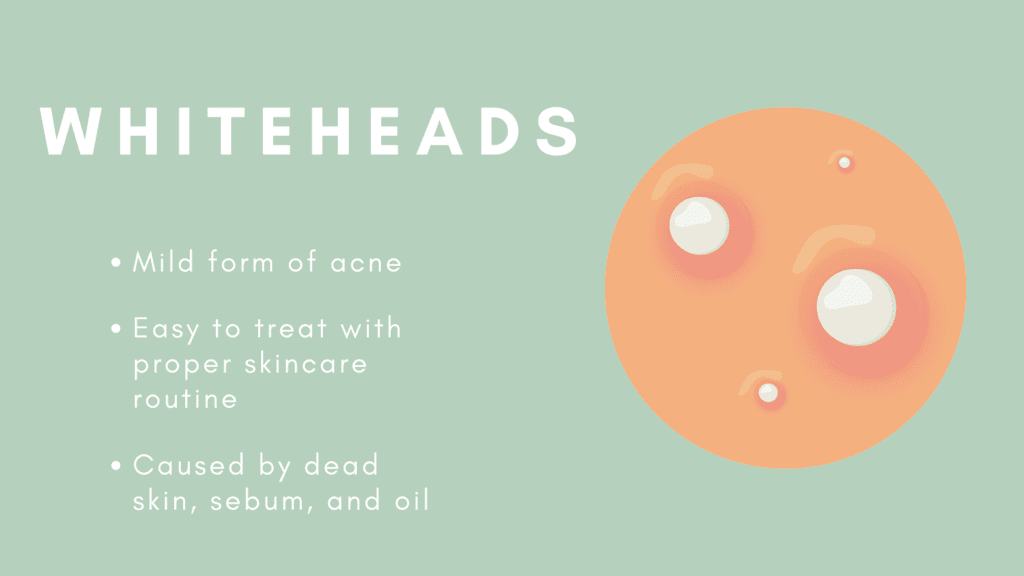
One of the most common types of pimple is whiteheads, also known as closed comedones. These spots occur when the pores remain closed but become clogged with dirt, dead skin, bacteria, or sebum. In appearance, they resemble very small, white-coloured spots on the skin. While they might look like they contain pus, there’s no pus inside the whiteheads; just dead skin and oil. Whiteheads don’t indicate inflammatory acne, just clogged pores. In terms of acne severity, whiteheads are mild conditions, easily fixed with a proper skincare routine.
What Causes Whiteheads?
Whiteheads can be caused by anything that sits on the skin and clogs the pores; whether it be oil, bacteria, make-up, or skincare products. When shopping around for skincare products, you’re going to want to avoid anything that includes comedogenic ingredients. Comedogenic ingredients are, as the name implies, ingredients which can clog the pores, which in turn cause unsightly whiteheads.
How To Treat Whiteheads
In order to get rid of whiteheads, your best bet is staying away from heavy skincare products and maintaining a healthy skincare routine. You should also always wash your face before bed and give it a rinse in the morning; this is especially important if you wear make-up throughout the day.
If your whiteheads “pop”, you should immediately wash out the would with soap and water. then apply an antibacterial salve like Neosporin, which is proven to reduce acne scarring.
Blackheads
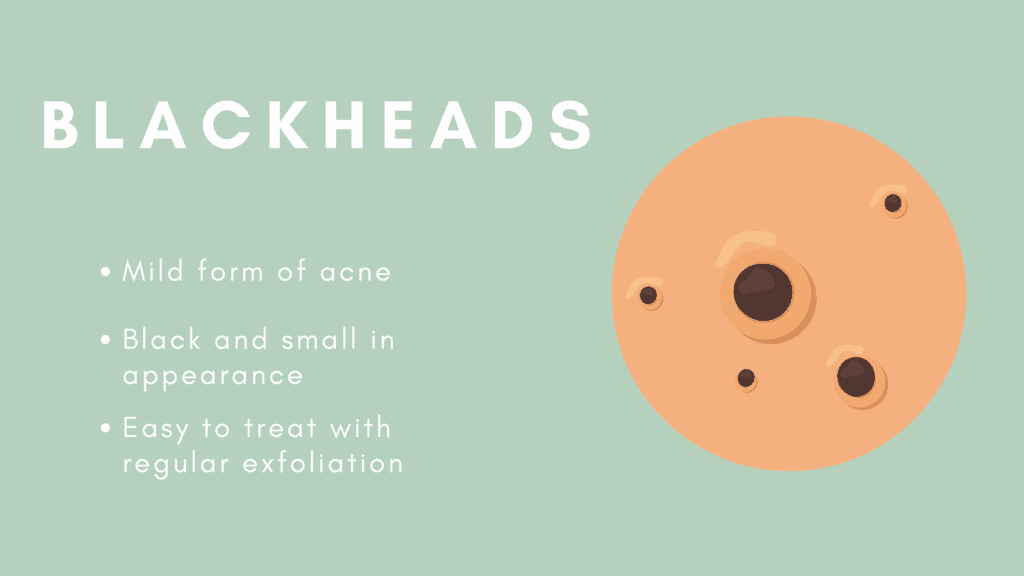
As common as whiteheads, blackheads (also known as open comedones) are also the result of blocked pores. The difference between whiteheads and blackheads is that the clogged pore is open, which makes it easier to unclog and remove the blackhead. In terms of acne severity, blackheads are similar to whiteheads; mild, and can be easily corrected with the right skincare routine. In appearance, blackheads are very small, and dark in color.
What Causes Blackheads?
Blackheads occur when the hair follicle becomes clogged with oil and dead skin cells. Blackheads typically occur on the nose, but can appear on the cheeks, forehead and chin area.
How To Treat Blackheads
You can avoid blackheads by using a gentle exfoliator 2-3 times a week, ensuring that you unclog your pores before applying any skincare, make-up, or other cosmetic products to your skin.
Hormonal Acne
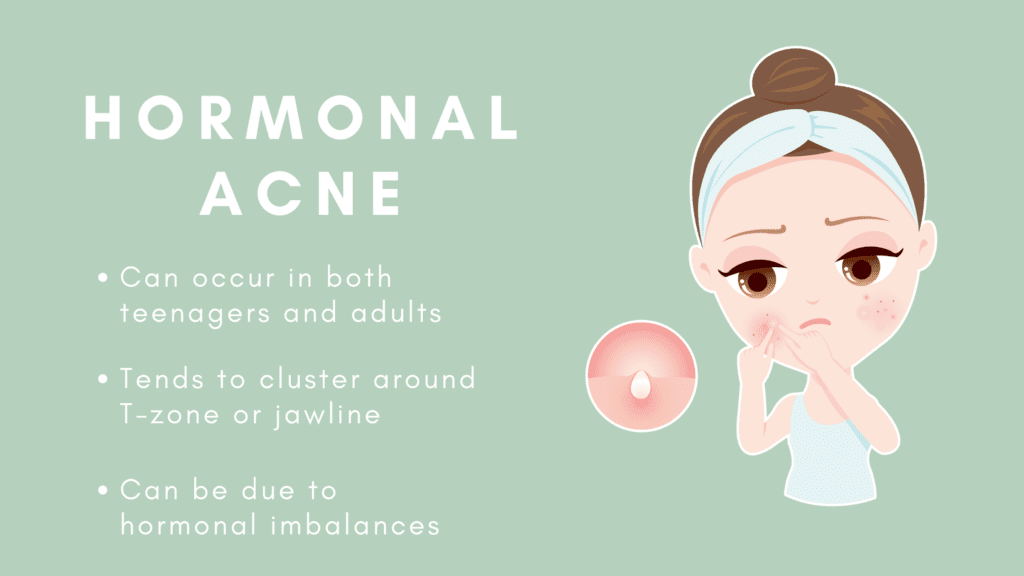
Hormonal acne is a form of acne that tends to show up during adolescence and puberty, but can also show up in adults who suffer from various hormonal imbalances or premenstrual syndrome.
What Is Hormonal Acne?
When hormonal acne occurs during adolescence, it typically shows up around the T-Zone; it is a result of excess sebum production and can affect both males and females. Teenage hormonal acne can often clear up on its own with age and proper care. In adults, hormonal acne tends to be a little more persistent, occurring in response to hormonal fluctuations or conditions such as PCOS. Hormonal acne in adults tends to occur around the jawline and chin. Some women will also notice outbreaks of hormonal acne once a month during their menstrual cycle, while remaining spot-free the rest of the month.
How To Treat Hormonal Acne
Teenagers dealing with hormonal acne should try maintaining a healthy skin care routine, a healthy diet, and changing their bedsheets regularly, as bacteria can often thrive on homeware such as towels, pillowcases, and bedsheets. If acne becomes severe, medical professionals can prescribe treatments such as Accutane to help manage hormonal acne. For girls, some doctors also advise taking a contraceptive pill that can help regulate hormones and clear up breakouts.
For adults with hormonal acne, it’s a good idea to speak to a medical professional to ensure that there are no hormone imbalances that could be causing your acne. As I wrote in one of my other articles, thyroid issues – in particular hypothyroidism – can often be the root causes of acne breakouts. As hypothyroidism causes pimples on the neck and jaw, it can often be mistaken for hormonal acne. You can take a look at my eBook, Unmasking Acne, for advice on thyroid protocol when it comes to treating acne.
Additionally, it is important to make sure you are using a hormonal acne-safe facial cleanser. Many cleansers contain harsh chemicals, alcohols, fragrances, or other comedogenic ingredients. If you are dealing with hormonal acne breakouts it is important to make sure sure you pick out a face wash that nourishes and hydrates the skin. This will help reduce overall inflammation as much as possible.
Fungal Acne
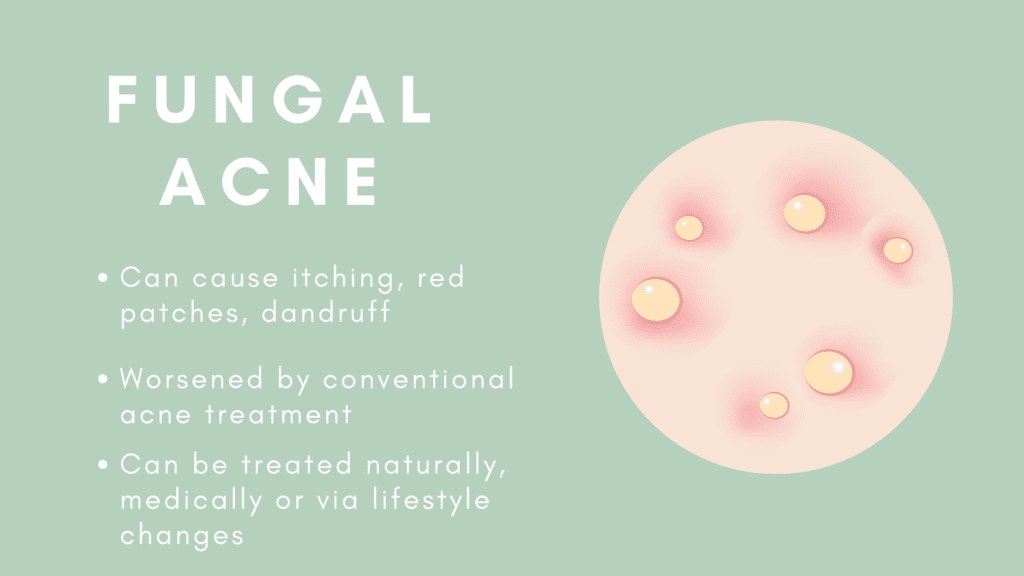
Fungal acne is one of the most misdiagnosed forms of acne and can be easily treated with the right diet, products, and natural remedies. In appearance, fungal acne might resemble whiteheads that become itchy and tend to cluster around the scalp; you might also suffer from dandruff and red, itchy patches on the skin. If this sounds like you, and no acne treatment works, you’re probably suffering from fungal acne. While fungal acne isn’t as severe as nodules or cystic acne, it can be uncomfortable and should be treated promptly.
What Causes Fungal Acne?
Fungal acne is caused by an overgrowth of yeast, which leads to an infection in the hair follicles in the skin. This might explain why traditional acne treatments don’t work with fungal acne – instead, the harsh chemicals and abrasives make it worse!
How To Treat Fungal Acne
To treat fungal acne effectively, you should first focus on making several lifestyle changes. Taking regular showers, eating less carbohydrates, trying to reduce stress, and avoiding certain heavy skincare products can all contribute to a reduction in fungal acne. You can also try various topical treatments – MCT oil can help you to get rid of fungal acne by killing Malassezia, the fungus responsible for the acne outbreak. You should always speak to a dermatologist if your symptoms persist, but trying natural methods is the best way to keep fungal acne at bay in the long term.
Papules Acne
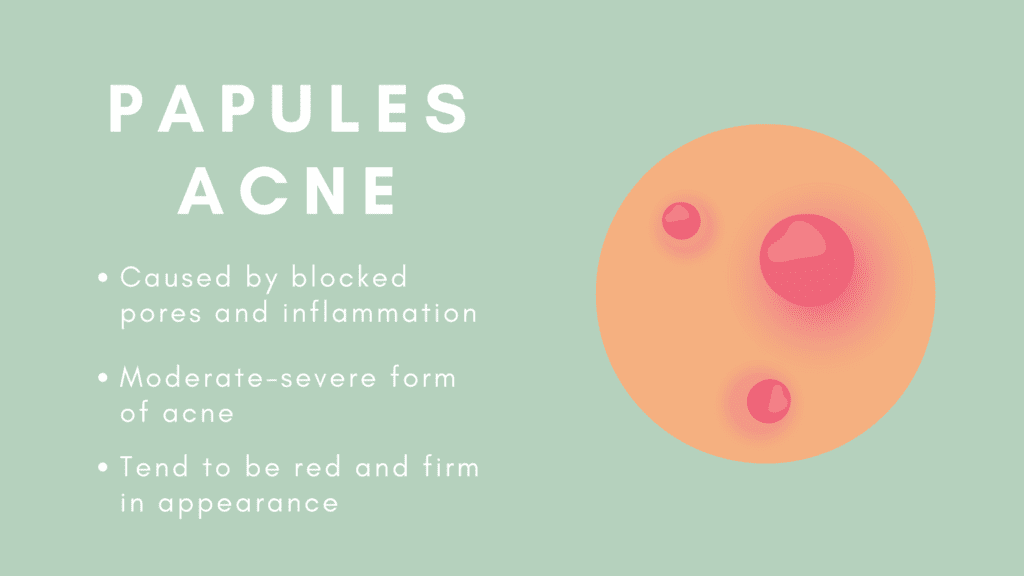
Papules can be categorized as a form of inflammatory acne, and are considered moderate to severe when it comes to acne severity grades. Papules are small (up to 1cm) red bumps that occur when the skin around your pores becomes too inflamed. Papules don’t contain pus, and tend to be rather firm to the touch.
What Causes Papules?
Papules are caused by a combination of clogged pores and skin inflammation, and can also occur when a hair follicle in the skin becomes blocked with dead skin, sebum and bacteria.
How to Treat Papules
Papules can be successfully treated with various antibacterial topical skincare products, such as benzoyl peroxide and salicylic acid. As papules are caused by inflammation, it’s also a good idea to eat a diet rich in antioxidants and avoid inflammatory foods (junk food, soda, etc.) If papules become severe, you should always seek medical attention and advice.
Pustule Acne
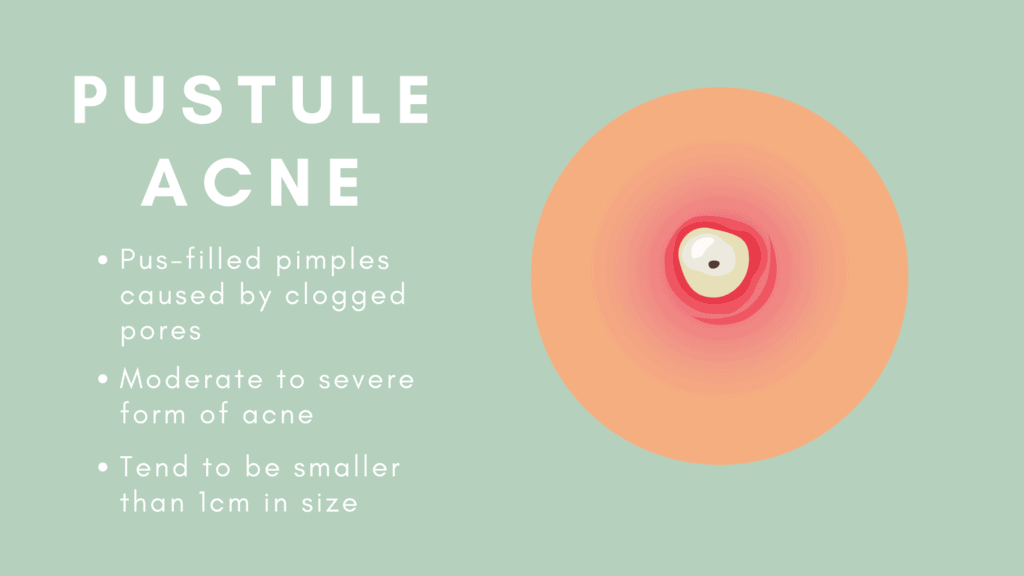
Similar to papules, pustules are another form of inflammatory acne. Pustules occur when the skin becomes inflamed and the pore is flooded with bacteria, oil, sebum, and dead skin. Pustules are filled with pus (bacteria) and are considered moderate to severe on the acne severity scale. Pustules have whiteheads, with the skin typically remaining red and inflamed around the pustule.
What Causes Pustules?
Pustules are caused by a combination of inflammation on the skin and clogged pores. Pustules can also spread on the skin if the skin comes into contact with the bacteria-filled pus from another pustule.
How To Treat Pustules
Moderate pustules can be treated with an uncomplicated skincare routine and antibacterial topical skincare products, such as benzoyl peroxide and salicylic acid. If they become severe, a dermatologist might try to drain the pus from the pustules in order to let your skin recover without further spreading the bacteria. DON’T pop pustules at home – you can cause scarring and spread the pustules further.
Nodular Acne
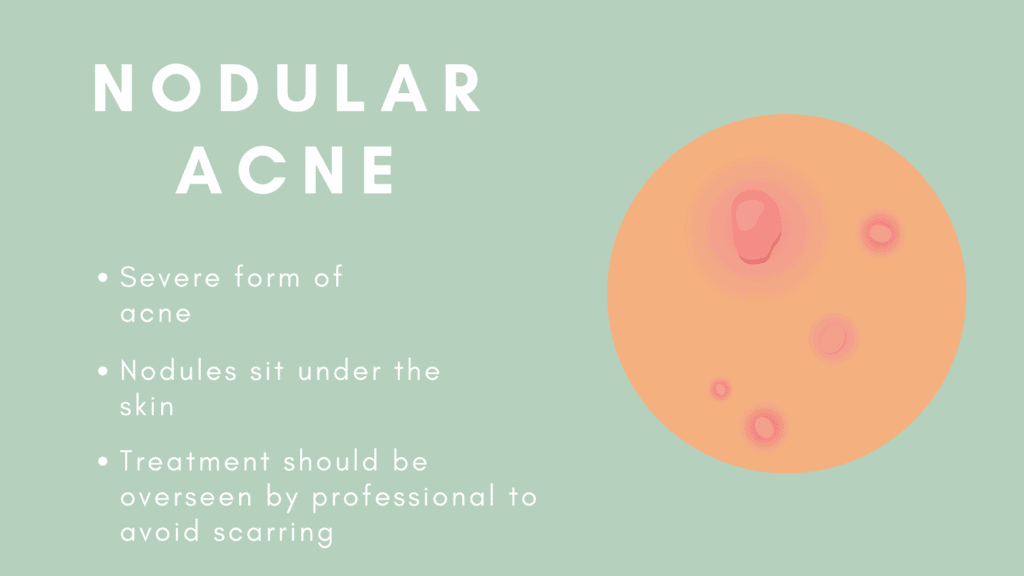
One of the most severe forms of acne, nodular spots can be distinguished by their lack of “poppable” heads – nodules reside underneath your skin, and can even blend into your skin in terms of their color.
What Causes Nodules?
Nodules are caused when blocked pores become increasingly inflamed and irritated; nodular acne can also occur when a bacteria referred to as p. Acne manages to clog pores on the skin.
How To Treat Nodules
As they remain under the skin, nodules cannot be treated at home with a topical skincare product. Nodules are typically treated via oral medications or medical procedures such as extraction. Your treatment will usually depend on the severity of your nodular acne.
Cystic Acne

Cysts are large, red, painful spots on the skin, similar in appearance to boils. Cysts reside even deeper under the skin than nodules, and are considered to be the most severe form of acne.
What Causes Cysts?
Like other forms of inflammatory acne, cysts form when the skin’s pores become clogged and blocked with bacteria, sebum, and dead skin. If you have sensitive, oily skin, you are more susceptible to cystic acne.
How To Treat Cystic Acne
Cystic acne is a serious and severe form of acne, with high potential for scarring. While some topical antibacterial treatments can help with the treatment of skin inflammation caused by cysts, medical advice and treatment should always be sought to get rid of cysts. Typical treatments include extraction, drainage, along with some oral medications.

